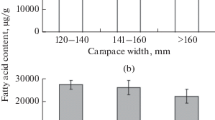Summary
The fatty acid composition in the male crayfish, Orconectes limosus, was analysed by gas-liquid chromatography. The fatty acids were found to have a specific distribution in different lipid classes. The composition corresponds to those of a “fresh water animal in winter” with the most important acids: C16∶0, C18∶1, C20∶2, C20∶4 (including about 53% of the total acids). In several lipid classes oddnumbered and branched chain fatty acids could be detected.
Potatoe and fish-liver oil diets influence the fatty acid composition. After four months feeding with fish-liver oil the fatty acids in the hepatopancreas and to a lesser extent in the “rest body” show a similar spectrum as the fed oil. After feeding for seven months with potatoes hepatopancreas and “rest body” exhibit a fatty acid composition representative for the untreated animal, which contains C18∶2 as well as higher unsaturated acids. These findings support the hypotheses that either the fatty acid composition in the structure lipids was maintained or that a C18∶2δ6,9-fatty acid was de novo synthesized and elongated analogous to the known vertebrate pathway.
Zusammenfassung
Das Fettsäurespektrum von männlichen Flußkrebsen Orconectes limosus wurde gaschromatographisch analysiert. Die Fettsäuren zeigen eine spezifische Verteilung auf die Lipidklassen. Das Gesamtspektrum entspricht dem Schema eines „Süßwassertieres im Winter“ mit den größten Fraktionen: C16∶0, C18∶1, C20∶2 und C20∶4 (zusammen rund 53% der Gesamtfettsäuren). In verschiedenen Fraktionen wurden ungeradzahlige und verzweigte Fettsäuren gefunden.
Durch Verfüttern von Kartoffeln und Lebertran kann das Spektrum beeinflußt werden. Die Fettsäuren in der Mitteldarmdrüse, und in weniger starkem Ausmaß im Restkörper, haben sich nach viermonatiger Fütterung mit Lebertran qualitativ und quantitativ dessen Spektrum angepaßt. Nach siebenmonatiger Fütterung mit Kartoffeln zeigen Mitteldarmdrüse und Restkörper ein Spektrum, das dem eines unbehandelten Kontrollkrebses ähnelt und sowohl C18∶2 als auch höher ungesättigte Fettsäuren enthält. Hierfür kommen zwei Deutungen in Frage: Entweder wird das Spektrum der Fettsäuren in Strukturlipiden aufrechterhalten, oder es erfolgt de novo Synthese einer C18∶:2δ6,9-Fettsäure und deren Verlängerung analog dem von Wirbeltieren bekannten Weg.
Similar content being viewed by others
Literatur
Bowyer, D. E., Leat, W. M. F., Howard, A. N., Gresham, G. A.: The determination of the fatty acid composition of semen lipids separated by thin-layer chromatography and a comparison with column chromatography. Biochim. biophys. Acta (Amst.) 70, 423–431 (1963).
Brockerhoff, H., Hoyle, R. J.: Conversation of a dietary triglyceride into depot fat in fish and lobster. Canad. J. Biochem. 45, 1365–1369 (1967).
Collatz, K. G.: Das Lipidspektrum des Flußkrebses Orconectes limosus und seine jahreszeitlichen Veränderungen. Z. vergl. Physiol. 65, 274–290 (1969).
Farkas, T., Herodek, S.: Paper chromatographic studies on the fatty acid composition of some fresh water Crustaceans. Acta biol. Acad. Sci. Hung. 10, 85–90 (1959).
—: Seasonal changes in the fat contents of the crustacean plankton in the lake Balaton. Ann. Biol. Tihany 27, 3–7 (1960).
—: The effect of environmental temperature on the fatty acid composition of crustacean plankton. J. Lipid. Res. 5, 369–373 (1964).
Graszynski, K.: Enzyme des Fettsäureabbaus in den Organen des Flußkrebses Orconectes limosus RAF. Z. vergl. Physiol. 60, 427–439 (1968).
Herodek, S., Farkas, T.: Seasonal changes in the fatty acid composition of Astacus leptodactylus. Biol. Közl. 7, 53–59 (1959).
James, A. T.: Qualitative and quantitative determination of fatty acids by gas chromatography. Methods of biochemical analysis, vol. 8, p. 1–59. New York and London: Interscience Publishers Inc. 1960.
Kuksis, A.: Quantitative lipid analysis by combined thin layer and gaschromatographic systems. Chromatog. Rev. 8, 172–207 (1966).
McGuire, J. L., Gussin, A. E. S.: Effect of diet on the lipid composition of the cockroach Blaberus discoidalis. Comp. Biochem. Physiol. 22, 427–434 (1967).
Pouka, R., Vasenius, L., Turpeinen, O.: Catalytic hydrogenation of fatty acid methylester, for gas-liquid chromatography. J. Lipid Res. 3, 128–129 (1962).
Schmit, J. A., Wynne, R. B.: Qualitative and quantitative lipid analysis by gaschromatography. Methods Bull. 117, F&M Scientific Corporation, Avondale, Penna. (1965).
Shorland, F. B.: The comparative aspects of fatty acid occurrence and distribution. In Comp. Biochem., vol. 3, p. 1–102. New York and London: Academic Press 1962.
Speck, U., Urich, K.: Der Abbau körpereigener Substanzen in dem Flußkrebs Orconectes limosus während des Hungerns. Z. vergl. Physiol. 63, 410–414 (1969).
Urich, K.: Die Biochemie der decapoden Crustaceen. Verh. Dtsch. Zool. Ges. Innsbruck (1968) (im Druck).
Wakil, S. J.: The synthesis of fatty acids in animal tissues. In: R. C. M. Dawson, D. N. Rhodes (edit.), Metabolism and physiological significance of lipids, p. 3–73, Proc. adv. study course Cambridge. London: J. Wiley & Sons Ltd., 1963.
Wolfe, D. A., Venkata Rao, P., Cornwell, D. G.: Studies on the fatty acid composition of crayfish lipids. J. Amer. Oil Chem. Soc. 42, 633–637 (1965).
Zandee, D.I.: Het metabolisme van Astacus astacus (L.) en enige andere Arthropoda. Thesis, Univ. Utrecht (1964).
—: Metabolism in the crayfish Astacus astacus (L.). IV. The fatty acid composition and the biosynthesis of the fatty acids. Arch. int. Physiol. Biochim. 74, 614–626 (1966).
—: Absence of cholesterol synthesis as contrasted with the presence of fatty acid synthesis in some Arthropods. Comp. Biochem. Physiol. 20, 811–822 (1967).
Author information
Authors and Affiliations
Additional information
Herrn Prof. Dr. K. Urich bin ich für die Anregung zu der vorliegenden Arbeit und für die Durchsicht des Manuskriptes zu großem Dank verpflichtet.
Rights and permissions
About this article
Cite this article
Collatz, KG. Das Fettsäurespektrum des Flußkrebses Orconectes limosus und seine Beeinflussung durch die Nahrung. Z. Vergl. Physiol. 65, 291–298 (1969). https://doi.org/10.1007/BF00298134
Received:
Issue Date:
DOI: https://doi.org/10.1007/BF00298134



